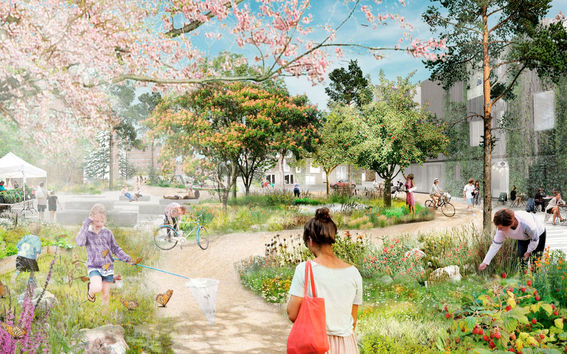Campus envisioned as a green oasis

An urban atmosphere, new homes for 7,000 people, more services, exercise options and playgrounds, but also more greenery, urban cultivation plots and nature. This is what the overall plan designed by Bjørn Ginman and Laura Myllyluoma of Danish landscape architecture firm SLA promises for the Otaniemi area.
“It is possible to combine greenery and the housing target set by the City of Espoo. We can introduce green spaces alongside and amidst the buildings and traffic routes in many ways,” Ginman says.
SLA is a specialist in sustainable landscape architecture. Chosen to design this project from amongst fifteen international firms, it is one of the best-known landscape architecture bureaus in the world. SLA won the Nordic Built Cities Challenge architecture competition in 2016.
The framework of SLA’s plan is formed by near-pristine shores and three green areas that dissect the urban environment. The focal point of development is on the south side. The extent to which the buildings and the environment have been worked on reduces gradually as you head north and east. Exercise stations have also been included in the compo-sition of the green areas.
The intention is to create a more urban feel to Otaniemi while at the same time shaping scattered green areas into coherent totalities.
Aalto University Vice President Antti Ahlava says the University’s strategic focal points – sustainable development, user orientation and developing the campus as a trial laboratory for the University – are emphasised in the plan.
“Sustainable development is associated with more than just building services, nor does user orientation mean that we should only promote cosy interior spaces. Both of these goals can be realised also in environmental planning and the outdoor spaces. SLA’s idea for environmental workshops that promote the involvement of residents and users likewise fit our strategy well,” he notes.
Applied bit by bit
This is the first time that the Otaniemi area is being considered as a single totality from the perspective of landscape architecture and environmental planning.
Ginman says the earlier lack of planning is evident. At present, Otaniemi has a lot of disused land and paved parking lots. The buildings are scattered here and there.
The intention is not to alter the situation in one fell swoop, and SLA’s plan might not be realised without modifications. The shaped vision serves as a foundation for the area’s more detailed planning in the future. It is likely that the plan will be modified and implemented bit by bit.
Ahlava praises the inclusion of ideas and proposals of a varying scale that can be adopted to practice according to suitability. The plan presents a big picture of the location of future construction work; on the other hand, it also includes detailed ideas on, for example, alternative ground cover materials. One suggestion is to use bricks from dismantled buildings as paving stones.
The plan is also alive by design. Our future way of life and associated needs are likely to be quite different for what we have now.
“If, for example, the significance of private cars reduces, the parking lots could be replaced with something else, like playgrounds,” Myllyluoma points out.
Strengths revealed
SLA wanted to emphasise the existing strengths of Otaniemi. These include its rich biodiversity, significant building historical heritage as well as its multidisciplinary and multicultural community.
“Landscape architecture can help in the creation of pleasant outdoor spaces that inspire people to go outside. Studies have shown that people interact more with one another in such environments. This promotes the occurrence of chance encounters. The Otaniemi community consists of people from many different countries and representing a variety of disciplines. It is our hope that people from different backgrounds would come together, giving rise to something new and innovative,” Myllyluoma says.
SLA’s vision sees Otaniemi as a walkable urban area. Everywhere can be reached easily via the numerous footpaths. The plan also contains more cycleways than now exist.
The aim is to reduce the importance of private cars in the area.
A communal urban cultivation area shared by the residents will also attract people to go outdoors and be active together. The conceptual illustrations are dotted with fruit trees and garden plots.
More than just aesthetics
SLA says landscape architecture has been going through quite an upheaval in recent years. Whereas earlier a landscape architect’s main job was to design aesthetic and cosy environments, today’s designers are tackling problems on a larger scale. Landscape architecture can help mitigate problems caused by, among other things, climate change or traffic and urbanisation.
“It looks like climate change is leading to substantially increased rainfall in the Nordic region. Landscape design can help deal with growing volumes of run-off rainwater. For example, you can build an artificial pond where water accumulates naturally. Vegetation can tackle noise and air pollution,” Ginman explains.
The Otaniemi plan includes themes for controlling run-off water as well as green roofs that improve air quality.
Environment and economy as equals
Ginman and Myllyluoma hope that Otaniemi will become an area that attracts people from elsewhere to come spend their time.
“This campus is quite unique on the global scale. I hope that you don’t take this for granted. Once you chop down a forest, you’ll never get it back,” Ginman says.
Cosiness and nature values are of economic significance as well. If an area is attractive, people are prepared to pay more for apartments. A pleasant environment also attracts new businesses.
“This has happened in our earlier design locations,” Myllyluoma says.
Time will tell what becomes of SLA’s plans. The University is considering the development of Otaniemi in cooperation with other landowners. Aalto University and the City of Espoo are presently sketching a local-plan-level design framework for Otaniemi.
“We have numerous smaller projects ongoing all the time. For example, the plan could first be applied along Otaniementie from the Learning Centre to the old shopping centre,” Ahlava reckons.
Text: Anu Vallinkoski. Photo: SLA.
This article is published in the Aalto University Magazine issue 22 (issuu.com), April 2018.
- Published:
- Updated:
Read more news

Student-driven projects to become Campus Sustainability Champions
This year, two student-led projects were selected as Campus Sustainability Champions. The awards were presented at the annual ACRE Day on 9 October 2024.
Aalto University Winter School teacher interview: "Great branding comes from solid substance"
We spoke with the teachers of the Winter School course Designing Brand Strategy to get a closer look at how students will learn to develop a successful and distinctive brand strategy through design thinking. This project-based course allows students to work in small teams to redesign the brand of an established Finnish company.
Holiday breaks and special opening hours at Arts infra
Special opening hours and exceptions at Arts infra workshops.